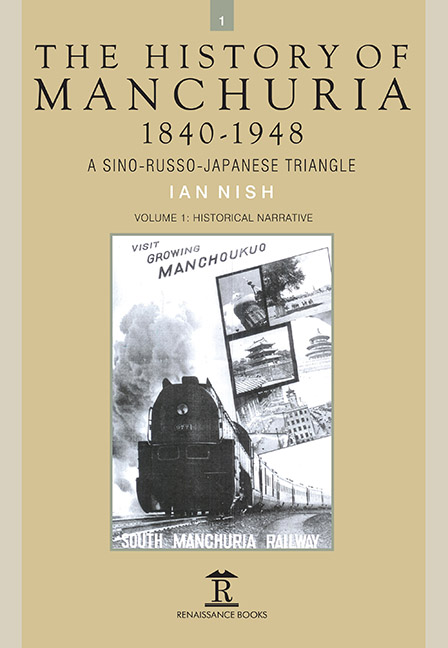Book contents
- Frontmatter
- Dedication
- Contents
- Preface
- Acknowledgements
- Name Conventions
- List of Abbreviations
- List of Maps
- Chapter One Manchuria and Russian Ambition, 1840s–1890s
- Chapter Two Sino-Japanese War and After, 1894–1900
- Chapter Three Prelude to the Russo-Japanese War, 1900–1905
- Chapter Four Railways, Reforms and Revolutions, 1906–1914
- Chapter Five Wartime Turmoil in Manchuria, 1915–1922
- Chapter Six Chang Tso-Lin’s Manchuria, 1922–28
- Chapter Seven Chinese Nationalism and Foreign Railways, 1929–1931
- Chapter Eight Lytton Commission in Manchuria, 1931–1932
- Chapter Nine Manchukuo: From Republic to Empire, 1933–1937
- Chapter Ten A Decade of Wars, 1938–1948
- Epilogue
- Map
- Select Bibliography
- Index
- Volume 2: Select Primary Sources
- Miscellaneous Frontmatter
- Dedication
- Miscellaneous Frontmatter
- Chapter 1 1840–1894
- Chapter 2 1895–1899
- Chapter 3 1900–1905
- Chapter 4 1905–1914
- Chapter 5 1915–1922
- Chapter 6 1922–1928
- Chapter 7 1929–1931
- Chapter 8 1931–1932
- Chapter 9 1933–1937
- Chapter 10 1938–1948
- Apendix Appeal by the Chinese Government
Chapter Ten - A Decade of Wars, 1938–1948
Published online by Cambridge University Press: 18 November 2023
- Frontmatter
- Dedication
- Contents
- Preface
- Acknowledgements
- Name Conventions
- List of Abbreviations
- List of Maps
- Chapter One Manchuria and Russian Ambition, 1840s–1890s
- Chapter Two Sino-Japanese War and After, 1894–1900
- Chapter Three Prelude to the Russo-Japanese War, 1900–1905
- Chapter Four Railways, Reforms and Revolutions, 1906–1914
- Chapter Five Wartime Turmoil in Manchuria, 1915–1922
- Chapter Six Chang Tso-Lin’s Manchuria, 1922–28
- Chapter Seven Chinese Nationalism and Foreign Railways, 1929–1931
- Chapter Eight Lytton Commission in Manchuria, 1931–1932
- Chapter Nine Manchukuo: From Republic to Empire, 1933–1937
- Chapter Ten A Decade of Wars, 1938–1948
- Epilogue
- Map
- Select Bibliography
- Index
- Volume 2: Select Primary Sources
- Miscellaneous Frontmatter
- Dedication
- Miscellaneous Frontmatter
- Chapter 1 1840–1894
- Chapter 2 1895–1899
- Chapter 3 1900–1905
- Chapter 4 1905–1914
- Chapter 5 1915–1922
- Chapter 6 1922–1928
- Chapter 7 1929–1931
- Chapter 8 1931–1932
- Chapter 9 1933–1937
- Chapter 10 1938–1948
- Apendix Appeal by the Chinese Government
Summary
FOR A DECADE after 1938 Manchuria was enveloped in a fog of war. Over the border in the Chinese heartland the war was under way with Japan against the background of the ongoing civil war between the Kuomintang government and the Communists. Within Manchuria there was recurrent fighting on the periphery between the Soviet Union and the Japanese where border disputes led dramatically to the Soviet invasion of the country in 1945. These were strategically significant but they were small in scale compared to the global issues which were arising in connection with the European conflict of 1939, the German invasion of Russia (Barbarossa) in 1941 or the Asia-Pacific conflict which also began in 1941. It might have been possible to stop our story in 1937 but that would have meant leaving out of our account the important effects in Manchuria of the dropping of the atomic bombs on Hiroshima and Nagasaki and the emergence of the civil war on the Manchurian plain. But it is a complex many-sided story and we can only give a concise account of it here.
An important theme in the early part of this chapter is Soviet-Japanese relations in Manchuria. Partly this was an inter-state confrontation in north Manchuria between countries with conflicting commercial and political interests. Partly it was the outcome of ideological differences. Under the strong influence of the army, especially the Kwantung army, Japan had followed an anti-Soviet policy which justified her in keeping large numbers of troops in Manchuria and her colony of Korea. Sharing her anti-Soviet policies was Nazi Germany. To that end Japan had entered into the Anti-Comintern Pact with Germany on 25 November 1936. Fearing that this was not enough, a group emerged which advocated converting the existing treaty into a military alliance with Germany and Italy. There were prominent lobbies opposed to this, especially after the outbreak of the European war (September 1939) and the signing of the Nazi-Soviet Non-aggression Pact (27 September). Eventually, Japan entered into an alliance with the Axis powers in September 1940. But loyalties were shallow in war; and outcomes were unpredictable.
- Type
- Chapter
- Information
- The History of Manchuria, 1840-1948A Sino-Russo-Japanese Triangle, pp. 187 - 210Publisher: Amsterdam University PressPrint publication year: 2016

